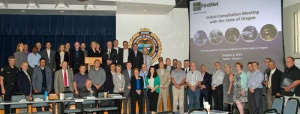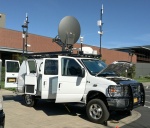
The iPhone is 10 years old.
Being from Seattle, Microsoft Country, I’ve always made fun of Apple. When I see people using Mac’s, I’ll say “oh, you use a computer made by a fruit company”. I talk about having a “mixed marriage”, as my spouse is a Mac user. During speaking engagements, if I suggest doing an online search, I’ll say “Bing it” (ok, that’s technically a put-down for Google, not Apple).
When I was Chief Technology Officer (also CIO) for the City of Seattle, we brought the first widespread use of mobile phones with email capability into that City government, in 2005, by introducing BlackBerrys. We had the support of major department directors as diverse as the Human Services Director and the Police Chief, Gil Kerlikowske.
But when I left City government in 2012, and needed to get a personal smart phone, I purchased an iPhone. My first-ever device made by the Fruit Company.
Why?
Ease of use. Robust apps and apps catalog. Integrated camera. Everyone writes apps for the iPhone first. Almost Schrier-proof.

In recent years products from other companies have eclipsed the iPhone in some respects. The Samsung Galaxy S7 (not the infamous Note 7) has a better camera, for example. But the smoothest, most integrated experience is still probably the Apple iPhone.
Today, of course, most companies issue iPhones or Android phones instead of Blackberrys to their field employees. Even government agencies do so: when I joined the federal First Responder Network Authority (FirstNet) in August, 2016, I was issued an iPhone 6.
But in Public Safety agencies – law enforcement, firefighting and emergency medical response – an agency-issued smart phone to field officers is still a rarity. Some large cities have done so – New York City for example. But despite the obvious benefits of having a mobile computer in the hands of cops and paramedics and firefighters, the initial device costs and monthly service fees seem beyond many city and county budgets.
In other words, ten years after its introduction, the capabilities introduced with the iPhone in 2007 still evade the average police officer, firefighter and paramedic responding to 911 calls every day.
That must change.
And it will.
Here’s why.
- Personal safety of responders. First responders have land-mobile radios for communication. They are dispatched by these radio systems which are very reliable, survive disasters and allow great communications. But these radios are voice only. No apps, no maps, no data or information transmitted. On December 17th Mount Vernon, Washington, Officer “Mick” McClaughry was shot and almost died when responding to a report of domestic violence. The shooter had a long and extensive history of weapons and violence, including the abduction of four people. This is an all-too-common story. When police officers, firefighters, paramedics and even child protective services social workers respond to a premise they deserve to have the full history of all calls to that premise, who is likely to be on site, and everything about the history of violence and use of weapons. Sent to their smart phone, immediately and upon demand, wherever and whenever they are.
- Phone calls and Siri. Responders need the ability to make phone calls from the field, using official, not personal, cell phones to continue investigations and contact victims, witnesses and suspects. Hundreds of millions of people simply press a button on their smartphone and say “Siri, call my friend Billy.” And the phone dials (or Facetimes) their friends and relatives. Siri, and its cousins Cortana, Alexa, Google Now, do much more than make phone calls of course. They answer questions and do web searches. Such capabilities would be extraordinarily helpful to first responders as they respond to 911 calls. We can even envision a “Hey Joe” Friday voice assistant specifically trained to respond to first responder queries.
 Digital evidence collection. Police officers, arson investigators, paramedics and other responders must collect vast quantities of information: photographs, interviews, serial numbers, video and so forth. Today that’s mostly done with spiral-bound notebooks, digital cameras, and pen and paper. With smartphones and tablet computers, all this information – including video clips of witness interviews and questioning of suspects in the field – could be accomplished more quickly and efficiently.
Digital evidence collection. Police officers, arson investigators, paramedics and other responders must collect vast quantities of information: photographs, interviews, serial numbers, video and so forth. Today that’s mostly done with spiral-bound notebooks, digital cameras, and pen and paper. With smartphones and tablet computers, all this information – including video clips of witness interviews and questioning of suspects in the field – could be accomplished more quickly and efficiently.- Patient care and tracking. Paramedics still, too often, fill out patient forms in quadruplicate on the patients they treat. With smart phones or tablet computers this work could be done digitally. Furthermore, emergency medical techs could access patient healthcare records, contact physicians and hospitals, and access a myriad of other information to better care for their patients.
- Situational awareness and geography. All the work of first responders involves geography. Maps, locations, the location of other responding units, the best driving route to a location and even building outlines depend upon maps. Responders urgently need this capability in their pocket.
- Many other uses. Anyone with a smart phone can envision dozens of other uses for such devices in the hands of first responders such as reviewing and uploading body-worn video, viewing building diagrams, finding the characteristics of drugs and hazardous materials, accessing criminal history records, helping with those in crisis or mentally ill, and so forth.

Of course, many departments put such capabilities in computers mounted in fire apparatus and police cars. But once the responder leaves the vehicle, all that capability is not available. Many responders, recognizing the advantages of mobile devices, use their personal smart phones or tablet computers, often contrary to their department’s policy. That carries significant dangers – giving their personal phone numbers to victims and suspects, for example, or potentially having their personal device confiscated as evidence once defense attorneys learn it has been used to collect photos or other information.
And the smart devices we issue to our responders don’t have to be iPhones. Many other companies make excellent mobile devices as well.
Private companies give smart phones and other mobile devices to their entire field workforces as well as all managers. In City governments, most managers and all elected officials have government-issued smart phones. We place our lives in the hands of first responders. Shouldn’t we give our police officers, firefighters, sheriff’s deputies, paramedics and other responders that same basic tool?
It is virtually criminal that 10 years after the introduction of the iPhone, we still leave most of our first responders without these devices.











